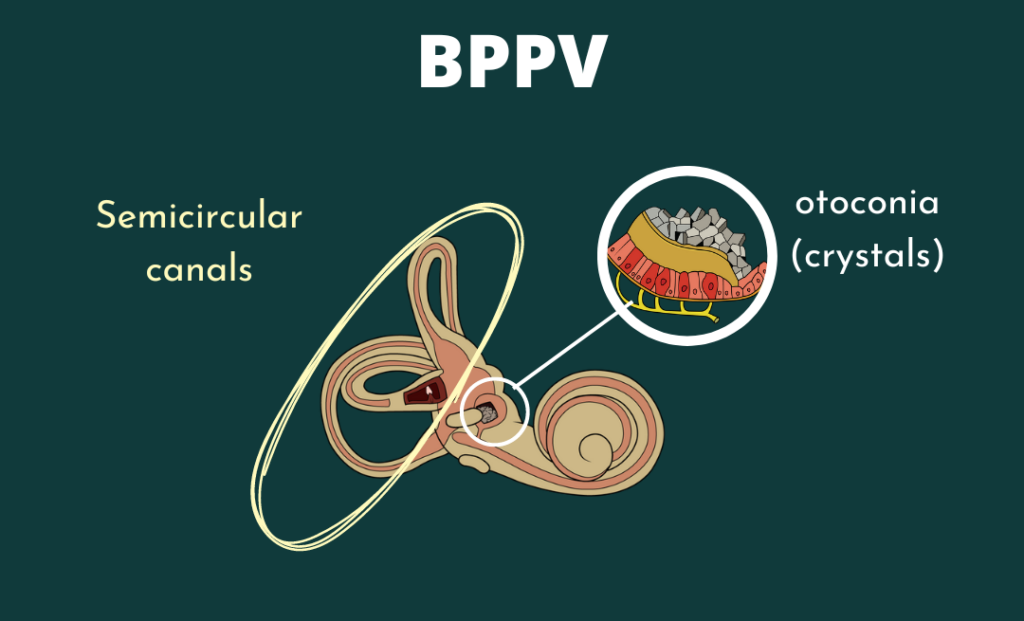Benign Paroxysmal Positional Vertigo (BPPV) is one of the most common causes of vertigo—a sudden spinning sensation often triggered by changes in head position. BPPV occurs when tiny calcium carbonate crystals (otoconia) in the inner ear become dislodged and migrate into the semicircular canals, disrupting your sense of balance.
Fortunately, there are several home exercises designed to reposition these crystals and alleviate symptoms. Always consult a healthcare provider before starting any treatment, but here are five commonly recommended BPPV exercises that you can do at home:
1. Epley Maneuver
Best for: Most common type of BPPV (posterior canal), especially if symptoms are triggered when lying back or rolling over in bed.
The Epley Maneuver is the gold standard for treating posterior canal BPPV and is often the first technique recommended. Please always learn this with your physical therapist and/or other medical provider.
How to Do It (for the right ear):
- Sit on your bed with your legs extended and turn your head 45° to the right.
- Lie back quickly with your head still turned. Let your shoulders rest on the bed, with your head hanging slightly over the edge. Hold this position for 30–60 seconds.
- Without raising your head, turn it 90° to the left (you’ll now be facing 45° to the left). Hold for another 30–60 seconds.
- Roll your body onto your left side while turning your head so you’re now looking down toward the floor. Hold for 30–60 seconds.
- Slowly sit up and remain seated for a few minutes.
Typically you will need 1-3 maneuvers of this. Please do not do this exercise unless directed by your doctor.

2. Semont Maneuver
Best for: Posterior canal BPPV, especially when Epley doesn’t work or when faster relief is desired.
The Semont maneuver involves quicker movements but can be more effective for some. Again, please only do this with your physical therapist or other healthcare provider.
How to Do It (for the right ear):
- Sit upright on the edge of a bed and turn your head 45° to the left (away from the affected side).
- Quickly lie down on your right side and stay there for 30 seconds to 1 minute.
- Without changing your head angle, rapidly move to lie on your left side. Your face should now be angled downward toward the bed. Hold for another 30–60 seconds.
- Return to a seated position slowly.
Typically you will need 1-3 maneuvers of this. Please do not do this exercise unless directed by your doctor.
3. Barbecue Roll Maneuver (For horizontal Canal BPPV)
This maneuver is for horizontal canal BPPV, which can sometimes be trickier to treat. But even if it’s tricky, it is always treatable. We recommend treatment under the guide of a provider like a physical therapist.
1. Start Position
- Lie flat on your back with a pillow under your head.
- Your head should be in a neutral position, facing upward.
2. First Roll
- Turn your head 90° to the right (toward the affected ear).
- Stay in this position for 30–60 seconds after spinning/nystagmus stops.
3. Second Roll
- Slowly turn your head and body another 90° to the left, so you’re lying on your back again but now your head is facing left.
- Stay here for 30–60 seconds after symptoms stop.
4. Third Roll
- Continue rolling your head and body another 90° to the left, now lying on your left side, head facing downward toward the floor.
- Hold for 30–60 seconds after symptoms stop.
5. Final Roll
- Roll your body another 90° to the left, ending in the prone position (on your stomach) with your head down or slightly turned to the left.
- Remain here for 30–60 seconds until spinning/nystagmus stops.
6. Sit Up
- Slowly push yourself up into a sitting position.
- Sit quietly for a few minutes until any lingering dizziness resolves.
Typically you will need 1-3 maneuvers of this. Please do not do this exercise unless directed by your doctor.
Note:
This maneuver typically requires clinical guidance, but a modified version may be done at home under instruction. It involves similar head-turning and lying down sequences but with a quicker pivot from one side to the other. If you’re interested in this technique, ask your vestibular therapist or ENT for step-by-step supervision.
Safety Tips for Home BPPV Exercises:
- Always confirm your diagnosis first. These exercises are specific to BPPV and may worsen other vestibular conditions.
- Have someone nearby. If you’re prone to strong vertigo episodes, it’s safest to have help nearby.
- Avoid sudden movements after the exercises. Give your body 10–15 minutes to settle.
Keep a symptom diary. Track when and how often you do the maneuvers and how you feel after.
Final Thoughts:
BPPV can feel scary, but it’s one of the most easily treatable causes of dizziness. With consistent use of these maneuvers—especially the Epley or BBQ techniques—most people experience relief within a few sessions. However, remember that there are other causes of positional vertigo. If you have questions about these, please listen to this podcast. If your symptoms persist or worsen, consult a vestibular specialist for further evaluation. The Healing Vertigo App is also a great resource for treatment of BPPV. Always remember that we have in depth course work and videos to help you do these exercises effectively and safely inside of Vestibular Group Fit!

Latest articles

7 Common Types of Vestibular Disorders: What They Are and How to Recognize Them

Central or Peripheral? Understanding Vertigo Made Simple





